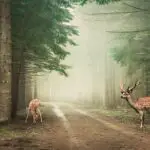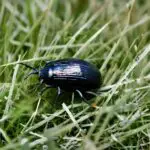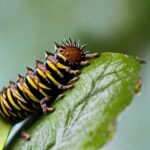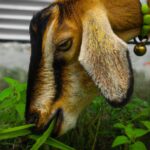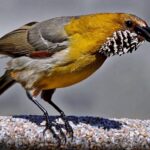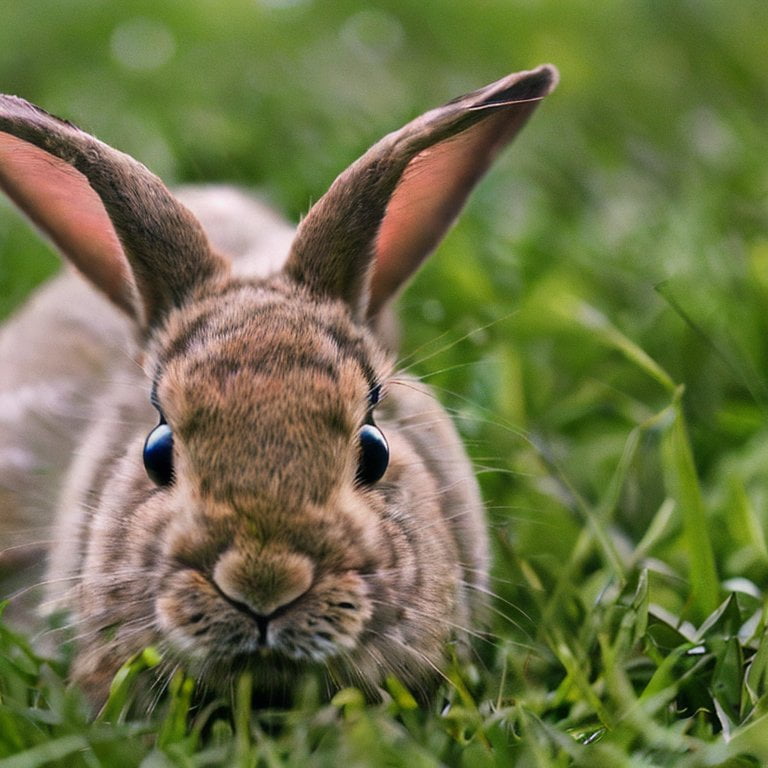
Grass is a common and widely available plant that is found in many different habitats around the world. Despite its abundance, not all animals consume grass as part of their diet.
However, there are many small animals that do rely on grass as a food source, either as their primary diet or as a supplementary food source. These animals have adapted to forage for and consume grass in different ways, such as using specialized teeth and digestive systems.
In this article, we will explore some of the small animals that eat grass in their diet, including what other foods they eat as well.
Which Small Animals Eat Grass?
Many small animals are known to eat grass as a part of their diet. Note that this is not necessarily the same as graminivores or grazers, which are animals that eat mainly grass in their diet. (See: Animals that Eat Grass are Called) For other lists of these animals that eat mainly grass, see What Animals Eat Grass in the Forest? and Farm Animals that Eat Grass and Insects That Eat Grass)
In this post we will look at examples of all small grass eating animals, even if they eat other foods in their diet and grass is not their main food source. Here are some examples of small animals that eat grass:
Rabbits
Rabbits are known to be herbivores and consume mostly grasses, clover, and other herbaceous plants. They eat mainly plant leaves and stems, but also consume fruits and vegetables. They can also be considered pests by humans as they can damage gardens and crops.
Pika
Also known as rock rabbits or mouse hares, are found in high-altitude and alpine regions of the world and eat mostly grasses, mosses, lichens, and other small plants. They also store food in caches which include grass, leaves and moss.
Sheep and Goats
These animals are known to consume grass, shrubs, and other plants. they are known to eat a wide variety of plants, including tough, woody plants that are less palatable to other animals.
There are many small animals that eat grass, including rodents, insects, and even some birds and reptiles. Here are a few examples of small animals that rely on grass as a primary food source:
Geese
Geese are waterfowl that primarily eat a diet of vegetation, such as grasses, sedges, and other aquatic plants. They have specialized beaks and tongues that they use to uproot and consume plants from the water or from grassy areas along the water’s edge.
They are known to eat a variety of grasses, such as cordgrass, cattails, and wild rice, along with other aquatic plants, like duckweed and water lilies. Some species of geese, such as Canada geese, have a diet that is mostly composed of grasses, while others, such as snow geese, have a diet that is more varied and also includes aquatic plants, grains and forbs.
Grass is a staple food for geese and it is a common food source for most species of geese. They consume it in large amounts and play an important ecological role in the habitats they inhabit.
Mice
Many species of rodents, such as field mice, are known to eat grass. They use their sharp incisors to nibble on the leaves and stems of grasses, and their diet may also include other plants, such as roots and seeds.
Field Mice will feed mainly on seeds and grass in their diet. However, for other mice, grass is not their favorite source of food, but will eat it when available or needed, since they are opportunistic eaters and will eat what is available, including a wide range of vegetation.
Prairie Dogs
Prairie dogs are small, burrowing rodents that are native to the grasslands of North America. They primarily eat grass, as well as other plants such as forbs and cacti. Prairie dogs are social animals that live in large colonies, and their extensive burrowing and foraging activities play a crucial role in maintaining the health of the grasslands.
Capybaras
Capybaras are vegetarians. And grass makes up 80% of their vegetarian diet.
Voles
Voles are small, mouse-like rodents that are found in grassy habitats all over the world. They are active year-round and eat mostly grasses and other plants. Voles are known to damage lawns, gardens, and agricultural crops by gnawing on the roots of plants.
Grasshoppers
Grasshoppers are a type of insect that can be found in nearly every habitat on earth. They are characterized by their long hind legs, which they use for jumping, and their diet consists mainly of grasses and other plants. They are an important food source for many animals, such as birds, lizards and even small mammals like shrews and moles.
Ducks
ducks do eat grass. Many species of ducks are omnivorous and have a diet that includes both plants and animals. While they primarily feed on aquatic plants, such as algae and pondweed, they also consume grasses, sedges and other terrestrial vegetation, when it’s available. They are known to forage in grassy areas along the water’s edge or around wetland habitats, where they consume leaves, seeds, and stems of grasses, as well as other types of plants. Some species of ducks, like the Mallard, have a diet that is more varied and also includes aquatic invertebrates, insects, and small fish.
It’s important to note that the diet of ducks can vary depending on the species and the time of year, therefore, not all ducks have the same dietary preferences. Grasses and other types of terrestrial vegetation can be an important food source for ducks during certain times of the year, particularly during the nesting season when they need to find food to support their energy needs and the growth of their chicks.
Larks
Larks are small songbirds that are found in grassland habitats throughout the world. They eat a wide variety of food, including insects, seeds, and small invertebrates, but also grasses and other plant matter are commonly consumed. Some species of larks, such as the horned lark and the shore lark, are specialists at foraging for food on open grasslands.
Beavers
Beavers eat mainly wood, bark, leaves, and aquatic plants. However, beavers will eat soft plants on occasion including grass.
Skinks
Skinks are a group of small lizards that are found in a variety of habitats, including grasslands. They are characterized by their small size, smooth scales, and long tail. Many skink species eat a diet mostly composed of insects, however, some species are known to eat fruits, seeds and also grasses.
Gophers
Gophers, also known as pocket gophers, are small burrowing rodents that eat mostly plants, including grasses, roots, and other underground parts of plants. They are known to eat a wide variety of plants, but they primarily consume grasses, clover, and other forbs that are found in their native habitats such as grasslands, meadows and fields. Gophers are known to consume the entire plant including the roots, stems and leaves. They use their strong incisors and their powerful jaws to gnaw through the plants and have a diet that is high in fiber.
Chickens
Yes, chickens can eat grass and many other types of vegetation. Chickens are omnivorous and have a varied diet that can include seeds, fruits, insects, and other small invertebrates. Chickens are known to forage on grass and other types of vegetation, such as clovers and other plants, when they have access to it. Grass is a good source of roughage and provides chickens with the necessary fiber in their diet, which helps them with their digestion, and also acts as a natural dewormer.
Chickens in backyard flocks and commercial egg and poultry operations are typically fed a commercial feed diet that is formulated to provide them with the necessary nutrients for growth and egg production. However, it’s also common for chickens to forage for their food, especially when they have access to a free-range environment, which allows them to find a variety of food sources including insects, seeds, and plants, including grass.
It’s worth noting that grass should be a part of chickens’ diets, but not the only source. Chickens require a balanced diet for optimal health and to produce eggs. So it’s important to offer them a variety of food sources to make sure that they receive all the necessary nutrients.
Lemmings
Lemmings are small rodents that primarily eat a diet of moss, grass, lichens and other vegetation. They consume leaves, stems, and roots of grass and other plant material that are commonly found in tundra and Arctic environments, where they live. They also eat some berries, seeds, and other fruits that are available during the summer months, but their diet is mainly composed of vegetation. They have a particular fondness for lichens and moss, which they may consume in high quantities during certain times of the year. Lemmings have a diet that is rich in fiber which helps them to survive in their arctic habitats.
Grassland & Desert Tortoises
Tortoises are herbivores and eat mainly plant-based foods. The grassland and desert varieties eat grass and herbs primarily in their diet.
Muskrats
Muskrats do eat grass as part of their diet, but it’s not their primary food source. Muskrats are semi-aquatic rodents that primarily consume aquatic plants, such as cattails, bulrushes, and lily pads. They also eat other aquatic vegetation like rushes, and sedges, and also eat the roots of these plants. Muskrats also consume some terrestrial plants, such as grasses, clover, and other forbs, when aquatic plants are not available. They also eat some fruits, berries, and even aquatic animals like mollusks and crustaceans, but plant material makes up the majority of their diet. They have specially adapted incisors that they use to gnaw through the tough vegetation they consume.
Jerboas
Jerboas are small rodents that primarily eat a diet of seeds and other plant material. They are found in desert and semi-desert regions, where they consume a variety of desert plants, such as grasses, shrubs, and cacti. They are known to consume leaves, stems, and seeds of grasses, as well as the seeds of other plants. They have specialized cheek teeth that they use to grind up the tough plant material they eat. Some species of jerboas, such as the five-toed jerboa, are known to consume insects and small invertebrates as well, but their diet is mostly composed of plants. They have a diet that is rich in carbohydrates and fibers, which helps them survive in arid habitats.
Agoutis
Agoutis are small rodents that are native to Central and South America. They primarily eat a diet of fruits, seeds, and other plant material. Agoutis are known to consume a wide variety of plants, including fruits, nuts, and berries, but they also eat leaves, stems and roots of grasses, as well as other types of vegetation. They use their sharp incisors to gnaw on the tough plant material and have a diet that is rich in fibers. They also consume insects and other small invertebrates, but the majority of their diet is composed of plant material. They are known to help disperse seeds in the ecosystem by carrying and burying fruits and seeds, which is an important ecological function in their native habitats.
Green Sea Turtle
The Green Sea Turtle’s primary source of food is seagrass and algae.
Bandicoots
Bandicoots are small marsupials that are native to Australia and Papua New Guinea. They are herbivorous and have a diet that primarily consists of insects, worms, fruits and seeds, but some species have been known to eat grass as well. Bandicoots are known to eat a variety of plants and vegetation types, depending on the species and the region they live in. For example, the Long-nosed bandicoot is known to eat a variety of fruits and seeds, as well as underground bulbs, tubers and fungi.
Eastern barred bandicoot, which is found in southeastern Australia, has a diet that is composed mostly of plant material, including grasses, fruits, and seeds. However, their diet changes with the seasons and availability of food, so when other food sources are scarce or less available, they may also eat grass.
In general, grass is not a staple food for bandicoots, but some species may eat it as a supplementary food source when it’s available.
Caterpillars
Although leaves are usually caterpillars’ main source of food, some species of caterpillars will feed on grass. Not only will caterpillars eat the grass blades, but also the stems and seeds.
Iguanas
Some species of iguana, such as the green iguana, are known to consume leaves, flowers, and fruits of trees, shrubs, and grasses making them herbivores or omnivores.
Larks
Some small birds such as larks are known to eat mostly grasses, seeds, and other plant material and they may consume small insects occasionally. Some examples of larks are the Horned Lark and the Shore Lark.
Quails
Quails are small ground-dwelling birds that are known to eat a variety of foods, including seeds, fruits, insects, and other small invertebrates. Grass is typically not a major component of their diet, but some species of quails, like the Northern Bobwhite, may eat small amounts of grasses, leaves, and other vegetation when it is available. They typically forage for food on the ground, looking for seeds and berries and also eating some insects, spiders and worms.
Buttons quail, a small bird native to Australia, also eat a variety of foods including seeds, fruits, insects, and other small invertebrates. They typically forage on the ground, eating a variety of grasses, herbs and also legumes.
It is worth noting that the diet of quails can vary depending on the species, their habitat, and the availability of food. Therefore, while grass may not be a major component of their diet, it can be a supplementary food source for some quail species.
Finches
Finches are small songbirds that primarily eat seeds and plant material, but depending on the species, the finches’ diet can vary. Many finches are seed-eaters, and their diet primarily consists of seeds from a variety of plants, including grasses. Some species of finches like the House Finch and the Goldfinch, will primarily consume seeds from trees, shrubs, and weeds, however, they can consume grass seeds as well.
(Learn more at Is a Bird a Herbivore?)
Possums
Possums, also known as opossums, are omnivorous marsupials native to North and South America. While possums have a varied diet that can include fruits, insects, and carrion, they also eat a significant amount of vegetation, including grass. Possums have been observed eating a wide variety of plants and have a diet that can include grasses, leaves, twigs, and bark of trees, as well as fruits, berries and seeds.
Different possum species have different diet preferences, Some species like the Virginia Opossum, that’s found in North America, is known to have an opportunistic diet, eating both plants and animals. They are known to consume a variety of plants such as fruits, berries, leaves, grasses, and also insects, worms, snails, and small animals like mice.
The Common Brushtail possum, which is found in Australia, is also an opportunistic feeder and its diet includes a variety of fruits, leaves, flowers, and vegetables, as well as some insects and small invertebrates. They also consume some grasses and other types of vegetation, when it’s available.
In general, possums can eat a variety of plants, but grass is not a staple food for them, but it’s a source of food that they will consume when it is available.
Potoroos
Potoroos are small marsupials native to Australia, and they have a diet that primarily consists of plant material, including grasses. Potoroos are known to consume a variety of plants and vegetation types, depending on the species and the region they live in. For example, the Long-nosed Potoroo, which is found in southeastern Australia, has a diet that is composed mostly of roots, tubers, bulbs and fungi, but also eat leaves and stems of grasses and other vegetation.
Potoroos are known to forage for food on the ground and consume a variety of plant material including grasses, shrubs, and herbs. They can also consume insects, and other small invertebrates when they are available, but plants make up the majority of their diet.
Grass can be an important part of the diet for potoroos, but it is not a staple food for them, it’s a source of food that they will consume when it is available, along with other vegetation types.
Geckos
Not all geckos eat grass, as it is not a common food source for this group of lizards. Most geckos are insectivorous, and their diet consists primarily of insects and other small invertebrates. However, some species of geckos, such as the Mediterranean house gecko, may eat a small amount of fruits and vegetables, including grass, when it is available as a supplementary food source. These geckos are known to be opportunistic feeders and will eat whatever is available to them, although their diet mostly consists of insects.
Shrews
Shrews are small mammals that are known to have a diet primarily consisting of insects, spiders, worms, and other small invertebrates. They have a very high metabolism and need to eat frequently to maintain their body weight. They are active hunters, and they consume a large number of insects and other small invertebrates each day.
However, some species of shrews are known to consume small amounts of plant material, such as seeds, fruits, and roots, when it is available and insects are scarce. Some species like the North American Short-tailed Shrew, are opportunistic feeders and will eat whatever is available, including small amounts of grass, seeds and fruits.
It’s important to note that grass is not a staple food for shrews and it is not a common food source for most shrew species. They are primarily insectivores and consume plant material as a supplementary food source when insects are scarce.
Final Thoughts
These are just a few examples of the many small animals that eat grass. The diversity of small grass-eating animals is a testament to the importance of this type of vegetation in the ecosystem.
Grass is a fundamental food source for many small herbivore animals that eat plants, as well as omnivores, providing them with the energy and nutrients they need to survive. Additionally, grass-eating animals play important roles in maintaining the health of grasslands and other grassy habitats, such as spreading seeds, aerating the soil, and controlling the growth of certain plant species.
Lance has been passionate about the plant-based diet and we have been following a whole food plant-based diet for over 5 years. We focus on health, natural healing, weight management, animal rights, and the health of the planet and environment by focusing on whole plant-based foods and sustainable practices.
Learn more at the About Me page and follow on social media at the links below.

